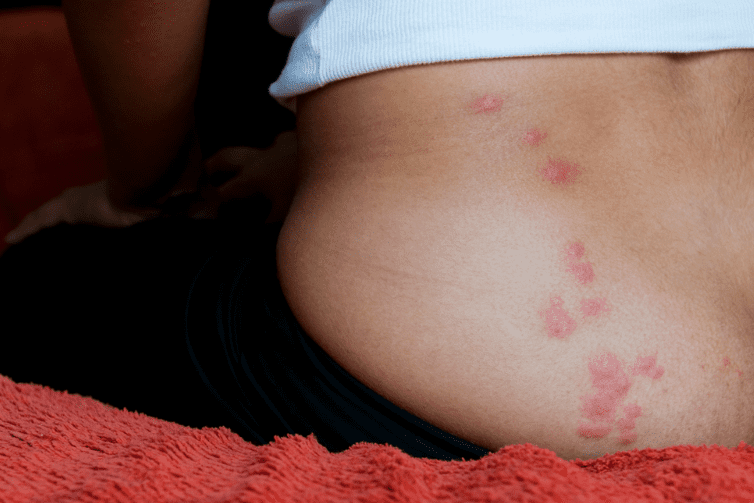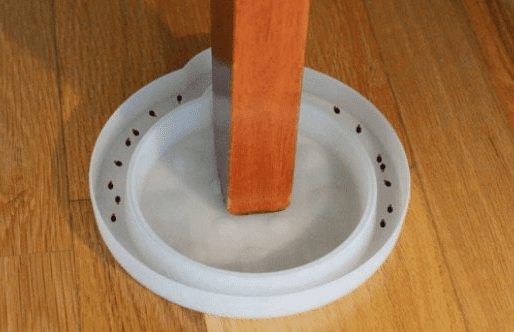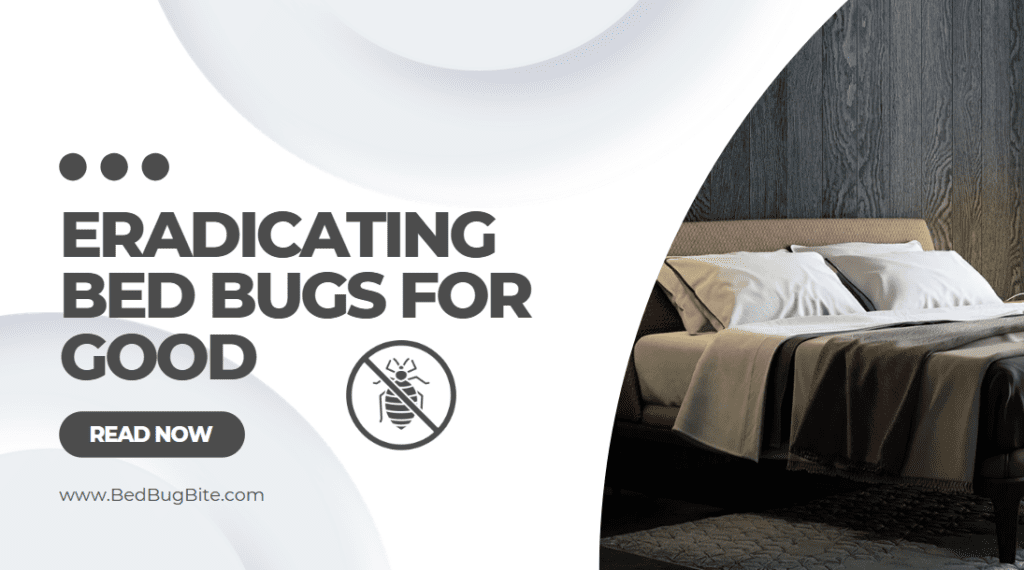Introduction
Eradicating Bed Bugs for Good. Welcome to our comprehensive guide on permanently eliminating bed bugs, a common yet challenging pest found in homes across the globe. Understanding bed bugs, their characteristics, and behaviors is pivotal in combating these resilient creatures. Bed bugs, known scientifically as Cimex lectularius, are notorious for their blood-feeding habits, primarily targeting humans. These nocturnal pests, often unnoticed due to their small size and secretive nature, can cause discomfort through their bites and stress to homeowners dealing with infestations. … To read more interesting Bed Bug Blogs, Click here!
Addressing a bed bug infestation promptly is crucial, not only for the well-being and comfort of those affected but also to prevent the spread of these pests to other areas. Bed bugs are adept at hitchhiking on luggage, furniture, and other personal belongings, making it easy for them to spread from one location to another. This mobility, combined with their rapid breeding capabilities, makes early detection and immediate action imperative. Ignoring a bed bug problem can lead to a more extensive and challenging infestation, requiring more time, effort, and resources to resolve.
What to expect
In this guide, you will find step-by-step strategies and expert advice to identify, treat, and prevent bed bug infestations effectively. From recognizing the early signs of an infestation to selecting the right treatment methods and implementing preventative measures, we cover every aspect you need to know to maintain a bed bug-free environment. With our detailed approach and your diligent effort, you can achieve lasting relief from these unwelcome guests.
For further insight into bed bug behaviors and habits, the Environmental Protection Agency (EPA) offers an extensive resource on understanding and managing bed bugs. This valuable information complements our guide, providing you with a well-rounded understanding of the topic.
As we embark on this journey together, remember that eradicating bed bugs is achievable with the right knowledge and tools at your disposal. Let’s dive into the world of bed bugs and explore how you can reclaim your space from these persistent pests.
Identifying Bed Bug Infestations
Understanding how to spot a bed bug infestation is the first critical step in dealing with these pests effectively. Bed bugs are masters of concealment, but certain telltale signs can help you detect their presence early, which is key to preventing a full-blown infestation.
Signs of Bed Bug Presence
Physical Indicators: Bites, Marks, and Stains

The most common indicators of a bed bug infestation are the bites they leave on your skin. These bites often appear as small, red, itchy welts, typically in a line or cluster. However, not everyone reacts to bed bug bites, so it’s essential to look for other physical signs. Small blood stains on your sheets, pillowcases, or mattress are red flags. Additionally, look for dark or rusty spots of bed bug excrement on bedding, mattresses, and walls.
Visual Confirmation: Finding Bed Bugs in Your Space
Adult bed bugs are visible to the naked eye, resembling apple seeds in size and color. During your search, focus on areas where people sleep or rest. Check seams of mattresses, bed frames, headboards, and furniture close to the bed. Using a flashlight can help in spotting these elusive pests. Remember, bed bugs can also hide in cracks and crevices in walls, floors, and even electrical outlets.
Common Areas Where Bed Bugs Thrive
Bedrooms and Sleeping Areas: Beds, Mattresses, and Bed Frames
Bed bugs are typically found in bedrooms, as they prefer close proximity to their human hosts. Inspect all parts of your bed thoroughly, including the mattress, box spring, and bed frame. Pay special attention to seams, tags, and hidden corners.
Beyond the Bedroom: Couches, Carpets, and Curtains
While bedrooms are the most common site of infestation, bed bugs can inhabit any area of a home. Check sofas, recliner chairs, carpets, and curtains, particularly if these items are in or near sleeping areas. It’s also wise to inspect closets and clothing, as bed bugs can attach to fabrics.
By understanding where to look and what signs to watch for, you can detect a bed bug infestation early, which is crucial for effective control. For more detailed information on identifying bed bugs, the University of Minnesota’s guide on bed bug identification provides a comprehensive resource, helping you to become more vigilant in spotting these pests in your home.
Preparing Your Space for Treatment
Before initiating any bed bug treatment, it’s essential to prepare your space properly. This preparation not only makes treatment more effective but also helps in preventing the spread of bed bugs to other areas. Effective preparation involves a combination of cleaning, decluttering, and isolating potential bed bug hotspots.
Initial Steps to Reduce Bed Bug Populations
Decluttering and Cleaning: Minimizing Hiding Places
Start by decluttering your space. Reducing clutter diminishes the number of places bed bugs can hide and makes treatment more effective. Focus on areas around your bed and any other infested areas. Follow this by thorough cleaning. Vacuuming can pick up bed bugs and their eggs from mattresses, carpets, and furniture. Be sure to dispose of the vacuum contents in a sealed bag outside your home immediately after cleaning.
Washing and Heat Treating Fabrics and Beddings
Bed bugs are sensitive to extreme temperatures. Wash all your bed linens, curtains, and clothing in hot water and dry them on the highest dryer setting. For items that can’t be washed, use a steamer to apply high heat. This process kills bed bugs at all stages of their life cycle, from eggs to adults.
Isolation Techniques
Encasing Mattresses and Pillows
Using special bed bug-proof encasements for your mattress and pillows can trap bed bugs inside and prevent new ones from getting in. Ensure the encasements are of good quality and check them regularly for tears.
Using Bed Bug Interceptors and Traps
Place bed bug interceptors under the legs of your bed and other furniture. These devices trap bed bugs as they attempt to climb up or down from your bed, helping to monitor and reduce their numbers. Additionally, various types of bed bug traps are available on the market, which can be used to detect and control infestations.

Properly preparing your space is a vital step in the bed bug eradication process. It not only aids in the effectiveness of treatment but also helps in monitoring the situation. For more insights on preparation and isolation techniques, consider exploring resources like the National Pest Management Association’s guidelines on bed bug prevention and treatment, which offer valuable advice on managing these pests effectively.
Choosing the Right Treatment Method
Selecting the most effective treatment method is crucial in the battle against bed bugs. There are various options available, each with its advantages and considerations. Understanding these methods and their appropriate applications will empower you to choose a strategy that best fits your situation, ensuring effective eradication of the bed bug infestation.
Chemical Treatments
Pesticides: Types, Application, and Safety Concerns
Chemical treatments, including various pesticides, are commonly used in bed bug control. There are different types of pesticides like pyrethrins, pyrethroids, desiccants, and biopesticides, each with specific usage guidelines and effectiveness. It’s crucial to follow the manufacturer’s instructions carefully and consider the safety of all household members, including pets, when using these products. Some bed bugs have developed resistance to certain pesticides, making it essential to use these products as part of a more comprehensive treatment plan. Eradicating Bed Bugs for Good
Understanding Resistance and Reapplication
Due to the increasing resistance of bed bugs to certain chemicals, it’s important to rotate pesticides or use a combination of products with different modes of action. Regular reapplication may be necessary, as most pesticides do not effectively kill bed bug eggs. Consult with a pest control professional to determine the best strategy and frequency for reapplication.
Non-Chemical Methods
Heat Treatment: Pros, Cons, and Effectiveness
Heat treatment involves raising the temperature of the affected area to a level lethal to bed bugs. This method can penetrate into hiding places that are difficult to reach with pesticides. However, it requires specialized equipment and should be conducted by professionals to ensure safety and effectiveness. Heat treatment is effective against all stages of bed bugs, including eggs.
Cold Treatment and Diatomaceous Earth: Alternative Options
Cold treatment, using temperatures below 0°F, can also be effective, but it requires a prolonged exposure time. Diatomaceous earth is another non-chemical option, which works by dehydrating the bed bugs. It’s important to use food-grade diatomaceous earth and apply it carefully to avoid inhalation.
Choosing the right treatment method for bed bugs can be complex. For more detailed information on bed bug treatment options, the [University of Kentucky’s entomology department provides extensive research and guidelines](https://entomology.ca.uky.edu/ef636) on effective bed bug control. This resource can help you understand the pros and cons of various treatment methods, aiding you in making an informed decision for your specific situation.
Hiring a Professional Exterminator
When dealing with bed bugs, sometimes the most effective course of action is to seek professional help. Professional exterminators offer expertise and resources that can be crucial in tackling severe or persistent bed bug infestations. Knowing when to call in a professional and how to choose the right one are important steps in ensuring your bed bug problem is effectively resolved.
When to Consider Professional Help
Assessing the Severity of the Infestation
If your DIY efforts have not successfully eradicated the bed bugs, or if the infestation seems widespread, it may be time to call in a professional. A severe infestation often requires more advanced, comprehensive treatment methods that only professionals can provide. Additionally, if you live in a multi-unit dwelling, professional intervention is advisable to prevent the spread of bed bugs to neighboring units.
Benefits of Professional Extermination Services
Professional exterminators have access to a variety of treatment methods, including more potent chemical treatments and industrial-grade heat treatments that are not available to the general public. They bring experience and knowledge to assess the infestation thoroughly and devise an effective, customized treatment plan. Professional intervention can also offer peace of mind, knowing that the problem is being addressed comprehensively.
Selecting the Right Exterminator
Researching and Comparing Exterminator Credentials and Reviews
When choosing an exterminator, do your research. Look for licensed, experienced professionals with positive reviews and a proven track record in bed bug extermination. Check their credentials and ask about their experience specifically with bed bug control.
Preparing for the Exterminator’s Visi
Once you’ve chosen an exterminator, prepare for their visit. This may involve cleaning and decluttering your space, as recommended by the exterminator. Be ready to follow their instructions both before and after treatment to ensure the best possible outcome.
Deciding to hire a professional exterminator is a significant step in your bed bug eradication journey. For guidance on selecting and working with pest control professionals, the National Pest Management Association provides valuable resources to help you make an informed decision and prepare for the exterminator’s visit. By choosing the right professional, you can significantly increase your chances of successfully eliminating bed bugs from your home.
Preventative Measures Post-Treatment
Once you have successfully treated a bed bug infestation, it’s vital to take steps to prevent future occurrences. Maintaining a bed bug-free environment requires ongoing vigilance and the implementation of preventive strategies. By adopting certain habits and practices, you can significantly reduce the chances of another infestation.
Maintaining a Bed Bug-Free Environment
Regular Cleaning and Inspection Routines
Consistency is key in preventing bed bug infestations. Regularly inspect and clean your sleeping areas and furniture. Vacuuming frequently, especially around beds and upholstered furniture, can help eliminate any lingering bed bugs or eggs. Also, wash and heat-dry your bed linens and curtains regularly. Keep your living space clutter-free to minimize hiding places for bed bugs.
Preventative Products and Practices
Consider using bed bug-proof mattress encasements and regularly checking them for damage. If you travel often, inspect your luggage and clothing for bed bugs when returning home to prevent accidental introductions. Be cautious when bringing second-hand furniture into your home, as it can be a common source of bed bugs.
Educating Yourself and Others
Staying Informed About Bed Bug Trends and Solutions
Stay updated on the latest information about bed bug control and prevention. This can include new treatment methods, changes in bed bug behaviors, and emerging trends in infestation occurrences. Websites like the Centers for Disease Control and Prevention (CDC) offer current information and guidelines on bed bugs and their management.
Sharing Knowledge to Help Prevent Future Infestations
Share your knowledge and experiences with others. Educating your friends, family, and community about bed bug prevention can help reduce the spread of these pests. Discussing strategies and tips for identifying and dealing with bed bugs can be invaluable in creating a collective defense against these pests.
Implementing these preventative measures is a crucial part of maintaining a bed bug-free environment. By staying vigilant and informed, and by adopting effective prevention practices, you can significantly reduce the risk of future bed bug infestations in your home.
Conclusion
Successfully navigating the challenges of a bed bug infestation and taking proactive steps to prevent their return marks a significant achievement in maintaining a healthy, pest-free living environment. In this comprehensive guide, we’ve explored a variety of effective strategies and methods to identify, treat, and prevent bed bug infestations. Let’s recap the key points and provide some final thoughts to reinforce your journey towards a bed bug-free home.
Recap of Key Strategies for Bed Bug Elimination
Reflecting on what we’ve covered, remember the importance of early detection, which hinges on understanding the signs of bed bugs and the common areas they inhabit. Preparing your space properly and choosing the right treatment method — whether chemical, non-chemical, or professional extermination — is crucial in effectively addressing an infestation. Finally, consistent post-treatment practices and preventive measures will safeguard your environment against future infestations. Eradicating Bed Bugs for Good
Encouraging Consistent Effort and Vigilance
The battle against bed bugs is ongoing and requires your continuous effort and vigilance. Regular cleaning, inspections, and staying informed about bed bug management are key to keeping these pests at bay. Remember, preventing bed bugs is easier and less costly than dealing with a full-blown infestation.
Final Thoughts and Additional Resources
As you move forward, keep in mind that bed bug control is a dynamic field, with new research and methods continually emerging. For additional information and updates, websites like the EPA’s bed bug resources provide valuable, up-to-date insights into bed bug management. Sharing this journey and knowledge with your community can also play a vital role in preventing the spread of bed bugs.
In conclusion, with the strategies and tips provided in this guide, coupled with your diligence and commitment, you are well-equipped to tackle bed bug challenges head-on. Remember, a bed bug-free home is not only about effective elimination but also about ongoing prevention and awareness. Eradicating Bed Bugs for Good




